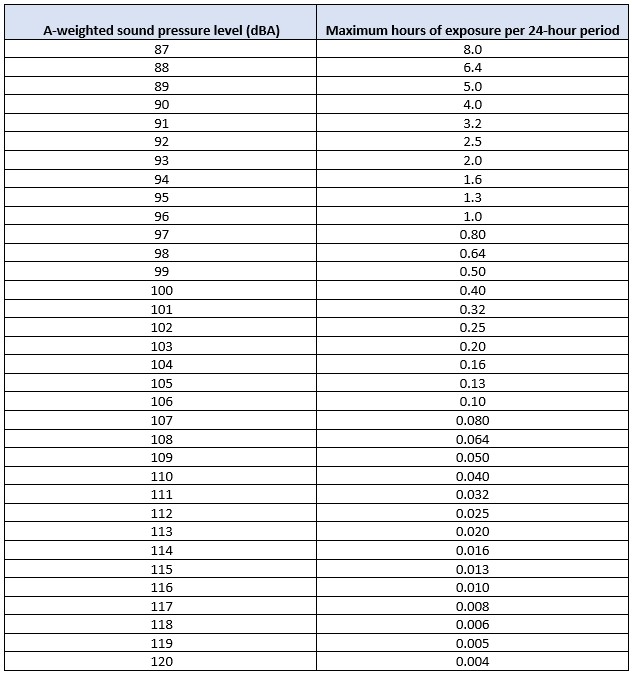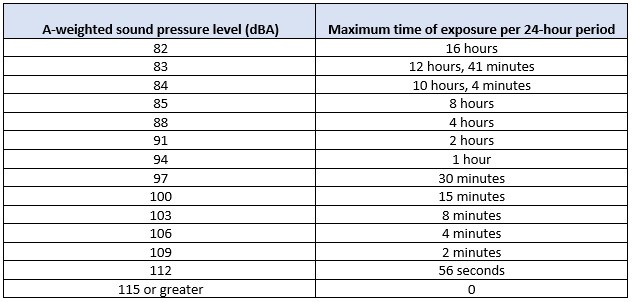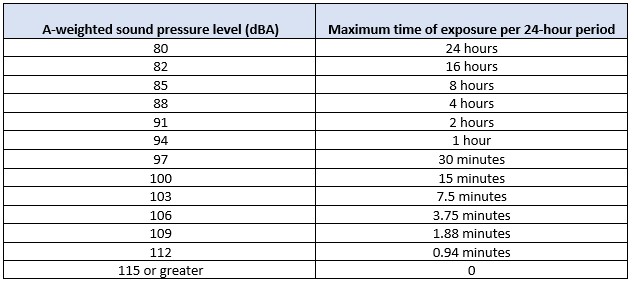Hearing Conservation – Know The Laws Around the Provinces
OHS noise hazard control requirements in each part of Canada. Here’s a summary of the specific OHS rules in each jurisdiction:
- FEDERAL
- ALBERTA
- BRITISH COLUMBIA
- MANITOBA
- NEW BRUNSWICK
- NEWFOUNDLAND
- NORTHWEST TERRITORIES & NUNAVUT
- NOVA SCOTIA
- ONTARIO
- PRINCE EDWARD ISLAND
- QUEBEC
- SASKATCHEWAN
- YUKON
According to Health Canada, over 6 million Canadian workers are exposed to workplace noise hazards. Among these, roughly 9,000 workers per year experience some form of hearing impairment, including tinnitus (ringing in the ears), due to overexposure to noise in the workplace. Excessive noise also increases the risk of incidents and injuries because it impairs workers’ ability to communicate and hear warning sounds. As a result, OHS laws require employers to control noise levels in the workplace by:
- Monitoring and measuring noise exposure;
- Keeping noise levels below specific occupational exposure limits;
- Furnishing hearing protection equipment to workers exposed at levels exceeding the limit;
- Posting warning signs to mark noise hazard areas;
- Furnishing audiometric testing to exposed workers; and
- In several cases, incorporating all of these measures into an integrated hearing conservation plan.
OHS Hearing Conservation and Noise Control Requirements Across Canada
FEDERAL
- Noise exposure assessment: required if employee may be exposed to A-weighted sound pressure level ò 84 dBA for duration likely to endanger his/her hearing (COHS Reg, Sec. 7.3(1))
- Noise Exposure Level: 87 dBA over 24 hours and shorter periods in accordance with following Schedule (COHS Reg, Sec. 7.4):

- Hearing protection: Must meet CSA Z94.2-M1984, Hearing Protectors, as amended from time to time (COHS Reg, Sec. 7.7(1))
- Hearing conservation program: Not specifically required
- Warning signage: Required at all areas of workplace at risk of exposure >87dBA (COHS Reg, Sec. 7.8)
- Audiometric testing: Not specifically required
- Other requirements: Employers using PPE as primary form of hearing protection must report in writing to MOL and workplace JHSC or health and safety representative (COHS Reg, Sec. 7.6)
ALBERTA
- Noise exposure assessment: meeting CSA Z107.56-06 required if workers may be exposed to A-weighted sound pressure levels (dBA) above exposure limits set out in Schedule 3, Table 1 (OHS Code, Sec. 219)
- Noise Exposure Level: 85 dBA over 24 hours and shorter periods in accordance with Schedule 3, Table 1 (OHS Code, Sec. 218):

- Hearing protection: Must meet grade for particular type of equipment in CSA Z94.2-02, as listed in Schedule 3, Table 2 (OHS Code, Sec. 222)
- Hearing conservation program: Written noise management program required if hazard assessment finds that workers exposed to hazardous noise levels (OHS Code, Sec. 221)
- Warning signage: Noise management program must provide for posting warning signs in any work area where noise level exceeds 85 dBA (OHS Code, Sec. 221(2)(c))
- Audiometric testing: Noise management program must provide for audiometric testing, including a baseline test within 6 months, a second test within 12 months after baseline test, and third or subsequent tests at least every 2 years after that (OHS Code, Sec. 223)
- Other requirements: Employers must retain noise exposure records for as long as they operate in Alberta (OHS Code, Sec. 220(2)(b))
BRITISH COLUMBIA
- Noise exposure assessment: meeting CSA Z107.56-94 required if workers may be exposed to A-weighted sound pressure levels above 82 dBA (OHS Reg, Sec. 219)
- Noise Exposure Level: 85 dBA Lex over 24 hours and 140 dBC peak sound level (OHS Reg, Sec. 7.2)
- Hearing protection: Must meet grade for particular type of equipment in CSA Z94.2-02 (OHS Reg, Sec. 7.7(1)(c))
- Hearing conservation program: Written noise control and hearing conservation program required if hazard assessment finds that workers exposed to noise levels above 85 dBA Lex or 140 dBC peak (OHS Reg, Sec. 7.5)
- Warning signage: Noise control and hearing conservation program must provide for posting warning signs in noise hazard areas (OHS Reg, Sec. 7.7(1)(b))
- Audiometric testing: Noise control and hearing conservation program must provide for hearing tests, including a baseline test within 6 months and new test at least every 12 months after that (OHS Reg, Sec. 7.8)
MANITOBA
- Noise exposure assessment: Meeting CSA Z107.56-13 required if: (a) workers may be exposed to A-weighted sound pressure levels above 80 dBA; (b) after a workplace alteration, renovation or repair; (c) after new equipment is introduced in the workplace; (d) after a modification to a work process that may result in a significant change in a worker’s exposure to noise; or (e) a worker provides employer evidence of an occupationally induced hearing loss. (WSH Reg, Sec. 12.2)
- Noise Exposure Level: 85 dBA Lex (WSH Reg, Sec. 12.1)
- Hearing protection: Must meet grade for particular type of equipment in CSA Z94.2-14 (WSH Reg, Sec. 12.3)
- Hearing conservation program: Not specifically required
- Warning signage: Required at entrance to any workplace or area with noise above 85 dBA (WSH Reg, Sec. 12.8)
- Audiometric testing: Baseline test within 6 months and retest at least every 2 years after that (WSH Reg, Sec. 12.4)
NEW BRUNSWICK
- Noise exposure assessment: Required if employer or employee ‘has reason to suspect’ that noise level may be above 80 dBA (OHS General Reg, Sec. 29(1))
- Noise Exposure Level: 85 dBA over 8-hour period and 140 dBC peak, in accordance with following schedule (OHS General Reg, Sec. 30(1)):

- Hearing protection: Must be adequate to keep noise exposure below required maximum levels (OHS General Reg, Sec. 32)
- Hearing conservation program: Not specifically required
- Warning signage: Work areas where noise level exceeds 85 dBA must be clearly marked with warning signs (OHS General Reg, Sec. 33)
- Audiometric testing: Not specifically required
NEWFOUNDLAND
- Noise exposure assessment: Meeting CSA Z107.56 required as part of hearing conservation plan (OHS Regs, Sec. 68(3)(a))
- Noise Exposure Level: 85 dBA average daily during 8-hour work day over 40-hour work week and 140 dBA peak (OHS Regs, Sec. 68)
- Hearing protection: Must meet grade for particular type of equipment in CSA Z94.2 (OHS Regs, Sec. 68(1)(b))
- Hearing conservation program: Required if workers exposed to noise above 85 dBA (OHS Regs, 68(2))
- Warning signage: Required at entrance to or periphery of any workplace or area with noise above 85 dBA; signs must also describe PPE required (OHS Regs, Sec. 68(5))
- Audiometric testing: Baseline test within 3 months and retest at least every year after that unless audiologist or occupational physician recommends more frequent tests (OHS Regs, Sec. 68(3))
- Other: Workers may request records of noise exposure during employment once their employment ends (OHS Regs, 68(7))
NOVA SCOTIA
- Noise exposure assessment: Required to ensure noise kept at or below exposure level but methods not specified
- Noise Exposure Level: 85 dBA averaged over 8 hours
- Hearing protection: Required if workers exposed to noise at or above exposure level
- Hearing conservation program: Not specifically required
- Warning signage: Required to mark work areas above 85 dBA
- Audiometric testing: Not specifically required
ONTARIO
- Noise exposure assessment: Required to ensure noise kept at or below exposure level but methods not specified
- Noise Exposure Level: 85 dBA Lex averaged over 8 hours (OHS Noise Reg, Sec. 2(4))
- Hearing protection: Equipment required if workers exposed to noise at or above exposure level (OHS Noise Reg, Sec. 4)
- Hearing conservation program: Not specifically required
- Warning signage: Required, where practicable, to mark work areas where noise level ‘regularly exceeds’ 85 dBA (OHS Noise Reg, Sec. 2(7))
- Audiometric testing: Not specifically required
PRINCE EDWARD ISLAND
- Noise exposure assessment: Meeting CSA Z107.56-06 required if worker or employer has reason to believe that A-weighted sound pressure levels (dBA) may exceed exposure limits (OHS Act General Regs, Sec. 8.4)
- Noise Exposure Level: 85 dBA over 8 hours per day and periods listed in schedule set out in Section 8(3) of Regs:

- Hearing protection: Must meet grade for particular type of equipment in CSA Z94.2-02 (OHS Act General Regs, 8.7(1)(d))
- Hearing conservation program: Written noise control and hearing conservation program required if hazard assessment finds that workers exposed to hazardous noise levels (OHS Act General Regs, 8.7(1)(b))
- Warning signage: Noise control and hearing conservation program must provide for posting warning signs in any work area where noise level exceeds 85 dBA (OHS Act General Regs, 8.7(1)(c))
- Audiometric testing: Noise management program must provide for audiometric testing, including a baseline test within 6 months, and subsequent tests at least every 12 months after that (OHS Act General Regs, 8.9(1))
QUBEC
- Noise exposure assessment: Meeting CSA Z107.56-13, 2014 or ISO 9612, 2009 required on daily basis (OHS Reg, Sec. 139)
- Noise Exposure Level: 140 dB peak and 85 dBA over 8 hours per day and periods listed in schedule set out in Section 137 of Reg:

- Hearing protection: Must meet grade for particular type of equipment in CSA Z94.2-2014 (OHS Reg, 141)
- Hearing conservation program: Not specifically required
- Warning signage: Employer must conspicuously post poster or other effective notification outside areas where hearing protection is required (OHS Reg, 141.3)
- Audiometric testing: Not specifically required
- Other: If workplace is above exposure limits, employer must do new noise hazard assessment and review selection of controls to keep at or below exposure levels at least every 5 years (OHS Reg, Sec. 133); ii. Employer must also identify changes to work situations that involve risk of exceeding exposure levels within 30 days of making changes and then carry out a new sound hazard assessment and, if necessary, select controls within 12 months (OHS Reg, Sec. 134)
SASKATCHEWAN
- Noise exposure assessment: Employer must measure sound levels in any work area where workers may be exposed to A-weighted sound pressure levels above 80 dBA, and after a workplace alteration, renovation or repair, introduction of new equipment, and/or a modification to a work process that may result in a significant change in a worker’s exposure (OHS Regs, Sec. 111)
- Noise Exposure Level: 85 dBA Lex (OHS Regs, Sec. 112)
- Hearing protection: Employer must provide equipment to workers exposed to above 85 dBA (OHS Regs, Sec. 113); employer must also provide equipment to workers exposed at 80 dBA to 85 dBA if they request it (OHS Regs, Sec. 112(b))
- Hearing conservation program: Required to establish (and review every 3 years) if 10 or more workers at a workplace are exposed or are believed to be exposed to noise above 85 dBA Lex (OHS Regs, Sec. 114(1))
- Warning signage: Required to mark sound levels of any area above 80 dBA Lex (OHS Regs, Sec. 111(5))
- Audiometric testing: Required at least every 24 months for workers exposed above 85 dBA Lex ((OHS Regs, Sec. 113(3))
- Other: If employer thinks it’s not reasonably practicable to reduce exposure below 85 dBA, it must provide written reasons to the JHSC or workers (OHS Regs, Sec. 113(2))
NORTHWEST TERRITORIES & NUNAVUT
- Noise exposure assessment: Employer must measure sound levels in any work area where workers may be ‘frequently’ exposed to A-weighted sound pressure levels above 80 dBA, and after a workplace alteration, renovation or repair, introduction of new equipment, and/or a modification to a work process that may result in a significant change in a worker’s exposure (OHS Regs, Sec. 114)
- Noise Exposure Level: 85 dBA Lex (OHS Regs, Sec. 116)
- Hearing protection: Employer must provide equipment to workers exposed to above 85 dBA (OHS Regs, Sec. 115(b)); employer must also provide equipment to workers exposed at 80 dBA to 85 dBA if they request it (OHS Regs, Sec. 112(b))
- Hearing conservation program: Required to establish (and review every 3 years) if 20 or more workers at a workplace are exposed or are believed to be exposed to noise above 85 dBA Lex (OHS Regs, Sec. 117(1))
- Warning signage: Required to mark sound levels of any area above 80 dBA Lex (OHS Regs, Sec. 114(5))
- Audiometric testing: Required at least every 24 months for workers exposed above 85 dBA Lex ((OHS Regs, Sec. 116(3)(c))
- Other: If employer thinks it’s not reasonably practicable to reduce exposure below 85 dBA, it must provide written reasons to the JHSC or health and safety representative (OHS Regs, Sec. 116(2))
YUKON
- Noise exposure assessment: Required to ensure noise kept at or below exposure level but methods not specified
- Noise Exposure Level: 140 dB peak and 85 dBA over 8 hours per day and periods listed in schedule set out in Section 4(3) of Reg:

- Hearing protection: Required for workers exposed to hazardous noise levels but standards not specified
- Hearing conservation program: Not specifically required
- Warning signage: Signs stating that a noise hazard exists and listing hearing protection required must be posted at entry to and periphery of work areas where noise is above exposure limit ( Health Reg, Sec. 5(4))
- Audiometric testing: Required within 6 months of initial exposure and at least every 12 months after that for workers ‘routinely exposed’ to noise levels above: (a) 80 dBA steady state noise for 8 hours; or (b) impact noise dB per daily impacts listed in schedule set out in Section 6(1) of Regulation